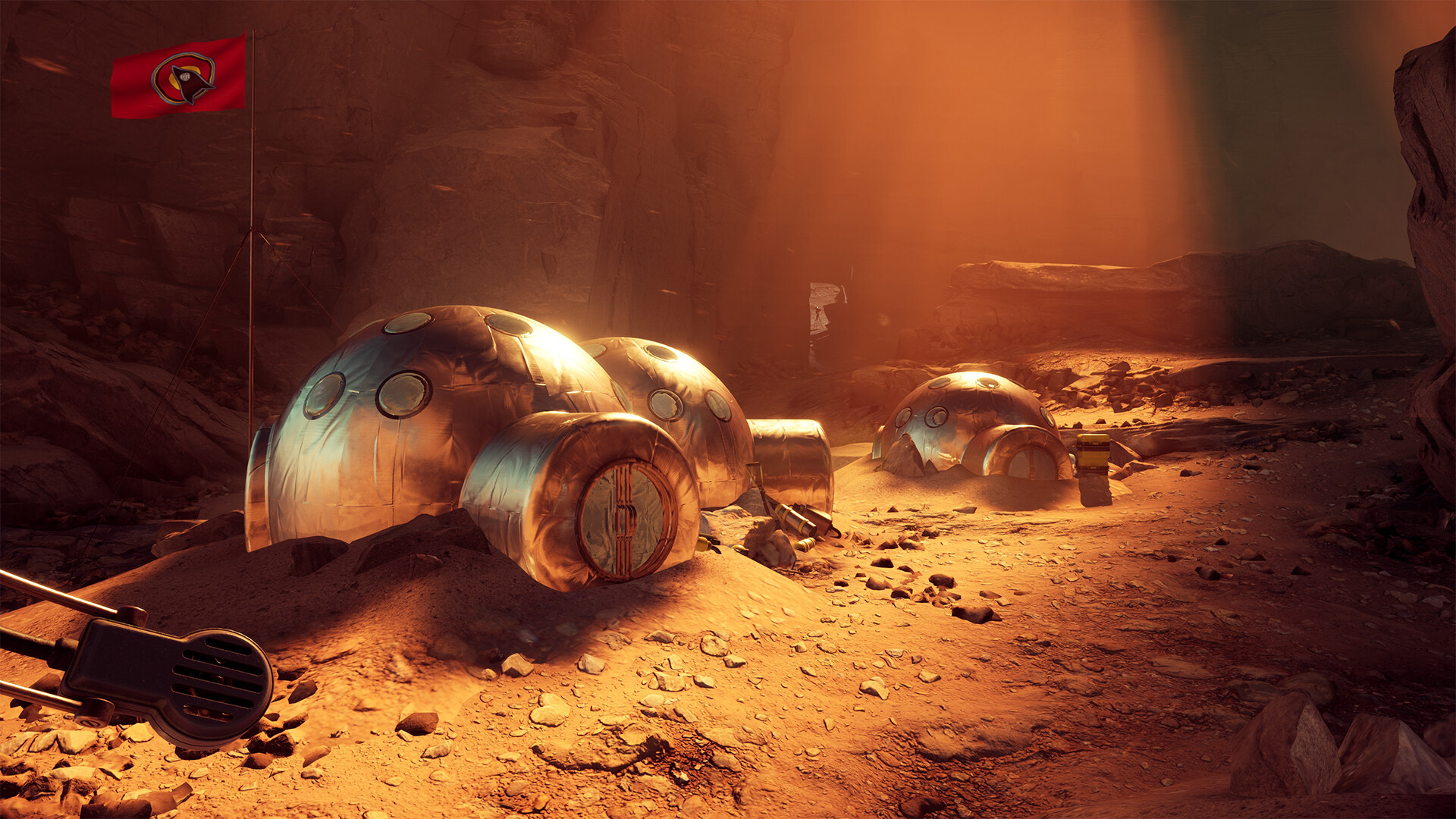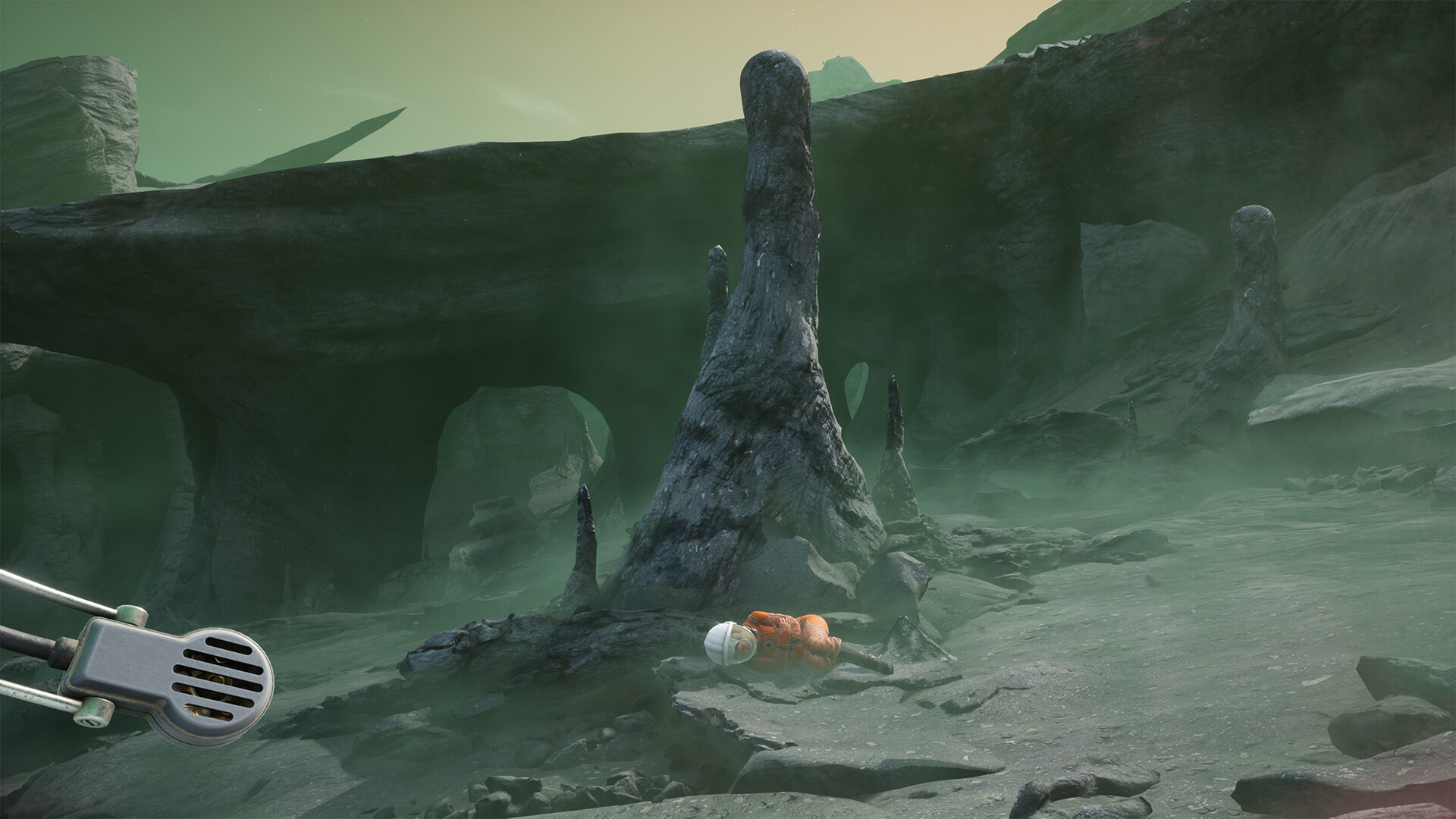Games colloquially known as walking simulators often get a bad rap because many believe that the inherent simplicity of gameplay, along with an emphasis on narrative makes for a weaker game. While I’m in no way going to try swaying you one way or the other in the argument, it is worth addressing the fact that, at its core, The Invincible is essentially a walking simulator. It has an incredibly strong emphasis on its narrative, and the core gameplay revolves around little more than walking around and using your various gadgets to explore the alien landscape around you.
“The Invincible is essentially a walking simulator.”
There is also another small bit of baggage that warrants discussion when it comes to The Invincible—the book that the game is, in its own strange and interesting way, adapting. The similarly titled book tells the story of the crew of a spaceship, dubbed The Invincible, that is trying to figure out what happened to the crew of The Condor on the planet Regis III. Without going into too much in the way of details for the book’s plot, it’s safe to say that, while reading it might present you with some spoilers, it can also really enhance the core narrative of the game.
Since it’s essentially the least important part of The Invincible, let’s talk about its gameplay first. Tasked with finding your missing crewmates, you have to explore Regis III by making use of maps, landmarks, and other tools at your disposal. Interaction with the world is limited to spotting things, talking about them, and occasionally flipping a switch or hitting a button. In fact, for the vast majority of the game, you’re just going to be walking—and sometimes also driving—around.
That’s not to say that you’re aimlessly wandering around, however. Right from the offset, your goals are always very clear, be it making use of visible landmarks and a sketched-out map to find your camp, to using the wonderfully retro-futuristic gadgets you have to find your crewmates. There’s never really any moment where you’ll be “lost” in terms of not knowing what you should be doing, and since most of the interactions in the game revolve around observations and conversations, this minimalist approach to gameplay lets the game’s story take center stage.

” Rather than making use of a more modern screen, the scanner in The Invincible instead makes use of a circular array of LEDs, each of which can blink, depending on the position of the signal relative to where you’re standing and looking.”
Setting everything else aside, the single best thing about The Invincible is its approach to futuristic gadgets. Harkening back to the art-deco aesthetics, just about everything you find in The Invincible feels like it would be right at home in a show set in the 1900s. The design of just about everything is a wonderful mix of the impracticality of classic sci-fi tropes, and the practicality of modern-day technology.
I have to give a shout out to the scanner, which lets you detect any nearby signals. Rather than making use of a more modern screen, the scanner in The Invincible instead makes use of a circular array of LEDs, each of which can blink, depending on the position of the signal relative to where you’re standing and looking. In essence, it’s basically an incredibly low-resolution screen, and by far my personal favorite sci-fi gadget design in a while. Other technology was seemingly designed in a similar way, with robot companions that feel like they belong on the cover of a pulpy sci-fi novel from the 60s, or even the metal detector essentially being a big CRT screen attached to a camera and a pistol grip.
The low-end sci-fi technology used in The Invincible goes quite well with the game’s general look. While Regis III might seem like a rather bland planet from the outset—you start out in a desert, after all—things don’t stay brown and sandy for too long. The hunt for your companions quickly takes you across a series of biomes, each with its own geological landmarks that you’ll often have to make use of in conjunction with your notebook to navigate. Since there aren’t really any big structures on Regis III, you’re going to have to work quite a bit harder to find your way around.

“The low-end sci-fi technology used in The Invincible goes quite well with the game’s general look.”
As I’ve mentioned in this review, the story is quite simply the most important thing about The Invincible. The game is trying to tell a rather personal story of crewmates that get separated while out on a scientific journey. Players are put into the shoes of scientist Yasna, who mysteriously wakes up on Regis III with a broken communicator and some severe holes in her memory. Making use of her notes, players will quickly have to start making sense of their surroundings and situation.
Thankfully, the whole game isn’t really about recovering Yasna’s memories; she’s pretty good at recalling important things, after all. Rather, players join Yasna on her quest to find all of her crewmates that landed on Regis III and get off the planet. The premise for the story is simple, and ripe for quite a few twists and turns along the way.
Alongside learning the fate of her crewmates, Yasna also discovers that something about Regis III is incredibly strange. Interestingly, a lot of the intrigue is left to be pondered, and the game isn’t particularly forthcoming with answers, choosing instead to focus on some of the more philosophical aspects of its story. The key mystery, however, revolves almost entirely around the nature of Regis III as a planet, and why the only fauna that seems to have evolved on the planet doesn’t seem keen on leaving its oceans.

“The key mystery, however, revolves almost entirely around the nature of Regis III as a planet”
The quality of the writing in The Invincible is held up to quite an extent by its rather spectacular voice acting and direction, both in terms of visuals as well as audio. Every action you can take in the game feels like it has some real weight to it, and even the simple act of hopping off a ledge can feel like an ordeal on its own, thanks in large part to the fantastic audio. Yasna in particular comes off as a wonderfully believable character, even if her propensity to fall into flashbacks can start feeling somewhat annoying at certain points.
The Invincible is a game held up in large part thanks to just about every single one of its aspects aside from the core gameplay. While there’s quite a bit of exploration, the gameplay isn’t really why you’d want to play the game in the first place. Rather, it’s the story, writing and characters that will pull you through.
The simple story of The Invincible may not be the most bombastic or fantastical one out there—it is based on a sci-fi book to begin with, after all—but rather, the quieter moments of the game, where Yasna is just looking up at the night sky and wondering about things aloud that really make the game what it is. Of course, it also helps that the game has incredibly strong art direction, with one of the best executions of the art-deco-inspired retro futurist aesthetic in a video game.
This game was reviewed on the PlayStation 5.